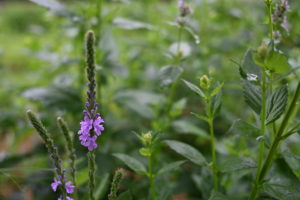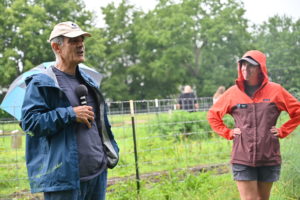If You Plant It, They Will Come
A dose of inspiration mixed with valuable partnerships leads to a garden oasis for people and pollinators in urban Waterloo.
Kamyar Enshayan did not plan to start a community garden the day he met Christine Kemp, the director of Peoples Community Health Clinic in Spring 2016.
The clinic is a full-service provider for the low-income community in the Waterloo, Iowa, area. That day, he was there to pitch the idea of a new vegetable voucher program. Instead, he would stumble upon a way to bring vegetables directly to the community – no vouchers needed.
“Just minutes into our meeting, I glanced out her [the director’s] office window and saw a half-acre lawn,” Kamyar says. “I immediately asked her if she would like to see that made into a garden. That was it. No forethought or plan, but I knew it could be done.”
Christine liked the idea and the clinic broke ground on the new garden in 2019. Today, the space is a thriving hub of life, with 20 plant beds that serve as a critical source of free, fresh produce for clinic patients, hosts, volunteers and AmeriCorps members. Over the last three years, the clinic garden has also become a food source for beneficial insects, thanks to a cost-share program from Practical Farmers of Iowa and Xerces Society.
“It’s right in the middle of a neighborhood that really has no trees, just a lot of concrete and asphalt,” Kamyar says. “The garden itself adds greenery to the area, and I always knew I wanted to add more biodiversity to the garden and in turn, the neighborhood.”

An aerial photo of the Peoples Community Health Clinic garden in Waterloo, Iowa, in 2023. Photo provided by Kamyar Enshayan.
Building Habitat, One Plant at a Time
With a goal of adding to the natural habitat, Kamyar applied for PFI’s beneficial insects cost-share program in 2023. Xerces staff worked with him to build a habitat plan and native plant list. To prepare the site, Kamyar used a combination of light tillage followed by cover crops as an organic method.
In May 2024, hundreds of native perennial grasses, sedges and wildflowers were planted as live plugs. Xerces staff, local volunteers and students helped install the native habitat. Straw mulch was also applied after planting to help suppress weeds and provide moisture for the young native plugs in the first growing season.
Native wildflowers like Virginia mountain mint, yarrow and golden alexanders give beneficial insects like beetles, flies and wasps a pollen and nectar source when prey may be absent. Native bunch grasses, meanwhile, are vital host plants for butterflies and moths and provide nesting and overwintering shelter for insects. It’s important for these insects to complete their entire life cycle and remain within the garden to fulfill their pollination and pest control services.
“It was incredible to witness squash bees visiting squash flowers during a PFI field day last July,” says Sarah Nizzi of the Xerces Society. “The weather was gloomy and rainy, but the conditions weren’t keeping the native bees away from their specialized food source. A true testament to ‘if you build it, they will come.”

Some examples of the pollinator habitat that’s planted in the Peoples Community Health Clinic garden in Waterloo, Iowa. Beneficial insects are also crucial for pollinating food crops.
A Garden Oasis
It’s now been a year since the cost-share project helped the Peoples Community Health Clinic’s garden add pollinator habitat. Most of the plugs planted have survived. In 2024, the clinic held a field day at the garden in partnership with Practical Farmers and Xerces Society. Throughout the event, it was clear the new habitat was already paying off. Field day attendees saw a variety of beneficial insects, including monarch butterflies, bumblebees and a host of native bees.
Adding this vital habitat also supports the garden’s success because of how important pollinators are to raising healthy food. Many garden crops depend on butterflies, bees, wasps and other insects for pollination. Predatory insects, such as wasps, also act as natural pest control by preying on beetles, aphids and other insects that feed on and destroy crops.
on beetles, aphids and other insects that feed on and destroy crops.
Ultimately, pollinator habitat creates a more sustainable and productive farming environment, benefiting both the urban community and the broader ecosystem. Looking back, Kamyar reflects on how all the pieces fell into place since that spring day in 2016. A garden he hadn’t planned on has become a cornerstone of the community.
Also available at the right time was the beneficial insects cost-share program. Without it – and Kamyar’s inspired vision to convert lawn into a local-food and habitat hub – neither people nor pollinators would have found an oasis in the middle of the city.
“Conservation does not occur in a vacuum. It takes multiple partnerships and individuals willing to try something new for us to push the needle forward. Farms and community gardens are critical to this work. We value the interest, time, labor and passion of so many like, Kamyar, who see the importance of supporting pollinators and beneficial insects and take action to make a difference.” – Sarah Nizzi

